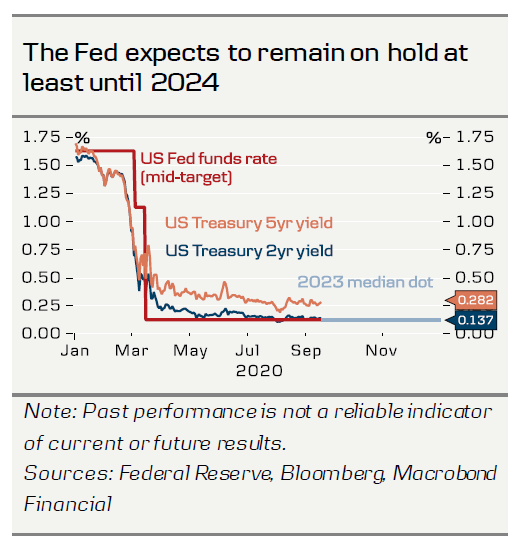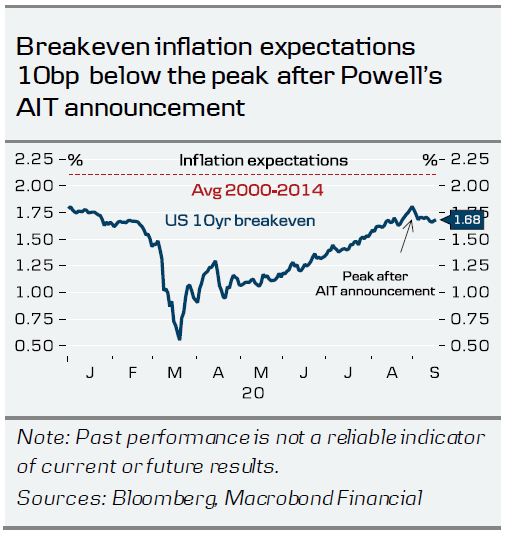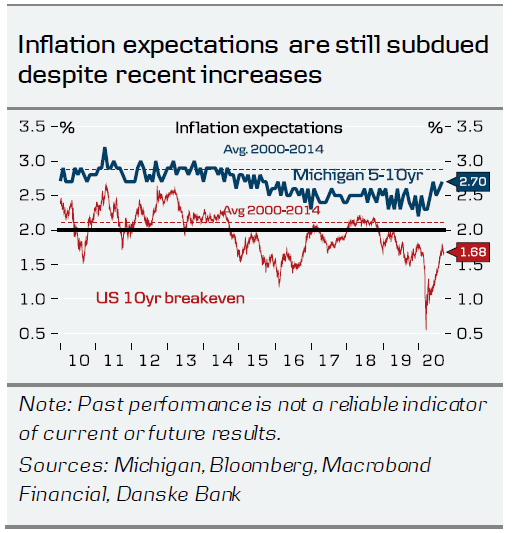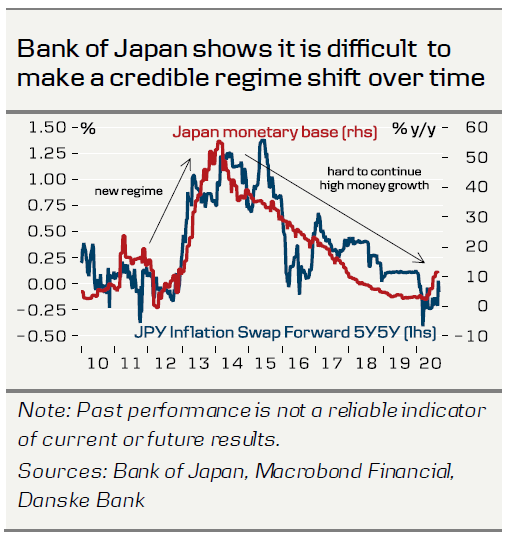Key takeaways
- On one hand, the Federal Reserve was not as dovish, as we had expected, but on the other hand not as hawkish as others had expected leaving the glass half empty/full. Basically , the message was “keep calm and carry on”, as the Federal Reserve will not hike rates until 2024 at the earliest.
- We think the meeting was a slight disappointment making it harder for the Federal Reserve to achieve its new inflation goal of 2% average inflation. We no longer expect increasing QE buying pace unless we see an economic setback or a more significant risk off.
- In our view, Powell’s p ress conference will likely mean the USD-negative reflation story is set to pause a bit longer. We now see the EUR/USD range as shifting from 1.18- 1.20 to being 1.17-1.19 but stick to our call of 1.23 in 6M time.
Actions speak louder than words
On one hand, the Federal Reserve was not as dovish as we thought, as it did not increase the QE buying pace. On the other hand, it was not as hawkish as other had expected, as it changed its forward guidance reflecting the new regime. So is the glass half full or half empty then? The answer is: it depends. This probably also explains why markets cheered at first but later reversed. 10yr breakeven inflation rates ended the day marginally below where they were just before the announcement . Overall, we think the meeting was a slight disappointment making it harder for the Federal Reserve to achieve its new goal of inflation averaging 2% over time. For now we do not expect further easing from the Federal Reserve taking out our call for more QE, at least until we get stronger signals. Unfortunately, the Federal Reserve is not as supportive for the recovery, as it could have been, which also means that the reflation theme will not be a strong as it could have been.
So why is the glass half full? The Fed maintained its target range unchanged at 0.00-0.25% and linked future rate hikes to realised inflation outcomes stating that “it will be appropriate to maintain this target range until labour market conditions have reached levels consistent with the Committee’s assessments of maximum employment and inflation has risen to 2 percent and is on track to moderately exceed 2 percent for some time”, very much in line with our expectations of a change in forward guidance reflecting the new flexible average inflation targeting regime.
During the p ress conference, Fed chair Powell made clear that “maximum employment” should be interp reted differently , as it is now a more “broad-based, inclusive goal”, i.e. the Fed will not tighten monetary policy just because the unemployment starts to fall significantly and in that way the tightening cycle after the Covid-19 crisis will be much different from the tightening cycle after the great financial crisis. Looking at the economic projections, the Fed is not expecting to raise rates through 2023.
While not making strong guidance on QE buying, the Fed is still stating it will buy “at least at current pace”. It seems fair to assume that the Federal Reserve will increase the buying pace in case we see a setback in the recovery, a significant risk-off in markets and/or inflation expectations start to fall. This may even happen in-between meetings given the flexible nature of the Fed’s QE p rogramme.
That sounds good so why is the glass half empty? The Federal Reserve had a great opportunity to show its determination in creating inflation and achieving its new goal by increasing the QE pace. Words mean a lot in monetary policy, but actions still speak louder. It is difficult to build credibility and it would be a very strong signal if the Fed had gone the extra mile. Looking at the inflation projections, the Federal Reserve does not expect PCE inflation (both headline and core) to return to 2% y/y until Q4 23, i.e. the inflation overshoot does not take p lace until bey ond the Fed’s own forecast horizon. Fed chair Powell dodged the question on why the committee is not projecting inflation above 2% over its forecast horizon. Given low inflation expectations among investors, consumers and even among the FOMC members, it seems strange the Fed did not think further easing was needed at this point.
Instead, Fed chair Powell urged everyone to be patient. “Time” was mentioned 42 times during the press conference (versus 27 in July and 31 in June). This does not seem like a central bank in any hurry to ease further, at least not in the short-run and perhaps also a hint that the members of the committee are disagreeing on the way forward. There were also two FOM C members voting against today ‘s announcement. Normally Fed chair Powell is more clear and precise during the press conference than today. Overall the lack of further easing is unfortunate, as economic research shows that monetary policy is more efficient if easing comes fast and forceful: the more you do now, the quicker you can also get out again. The Federal Reserve is very different from the ECB and the Bank of Japan in many ways – also in terms of inflation – but still today ‘s announcement suggests 0% rates and QE buying in the US for a very long time, i.e. very little volatility.
FX: USD-negative reflation story is set to pause a bit longer
For EUR/USD, the FOMC meeting was (given our expectation to a test of 1.20) somewhat of a lacklustre. Rather, spot declined about 30 pips to 1.1799, which seems quite related to the concurrent decline in US equities. In our view, Powell’s press conference will likely mean the USD-negative reflation story is set to pause a bit longer. Thus, our 1M forecast of 1.21 is very unlikely to be realised. Instead, we now see the EUR/USD range as shifting from 1.18-1.20 to being 1.17-1.19. Looking ahead 3-12M, we continue to see an economic recovery which is stronger-than-consensus and a resolution of Brexit – all amid calm in intra-European politics. Adding in continued policy support (especially from China), mean we stick to our call of 1.23 in 6M time. We also continue to recommend to hedge USD-income in forwards. Thus, renewed USD strength on the back of market turmoil will not be tolerated at Fed, but conversely, they are not in the business of adding to near-term USD weakness, in our view.


















